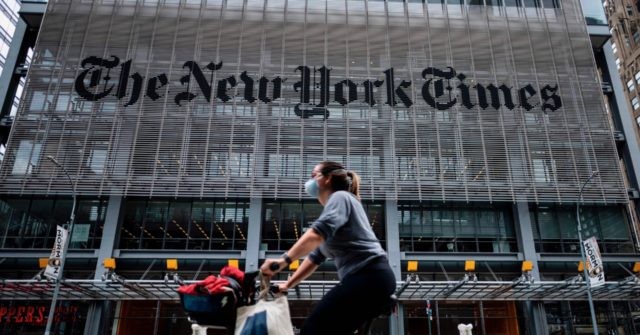The New York Times was accused of spreading false information about the UK’s coronavirus vaccine guidelines after publishing an allegedly misleading article and post on social media.
In an article entitled “Britain opens the door to mixed and worrying vaccinations”, New York Times writer Katherine J Wu said the UK “quietly updated its vaccination manual to allow for a combination vaccine regimen”.
The publisher of British Medical Journal, Fiona Godlee, denied this statement and urged the American left-wing newspaper to promptly issue a “highly visible correction”, according to the BBC.
Mrs. Godlee continued to characterize the New York Times report as “seriously misleading and requires urgent correction” and that there is currently no government recommendation to “mix and match” different vaccines against the coronavirus.
Contrary to NYT claims, Public Health England chief immunizations, Dr. Mary Ramsay, said: “We do not recommend mixing Covid-19 vaccines – if your first dose is the Pfizer vaccine, you should not receive the AstraZeneca vaccine. second dose and vice versa. “
Dr. Ramsay said that although there may be “extremely rare occasions” when the second dose of a vaccine is not available or if it is not known which vaccine the patient initially received, it may be “better to give a second dose of another vaccine than not at all”.
The British government’s Green Paper for coronavirus vaccinations states that “every effort” must be made to ensure that patients receive the same vaccine for the second dose. And he goes on to note that: “For individuals who started the regimen and who come for vaccination in a place where the same vaccine is not available, or if the first product received is unknown, it is reasonable to offer a dose of the local product available to complete the schedule. “
Far from responding to BMJ’s claims, the NYT subsequently published a second article, reformulating its previous position. Other news outlets like the Guardian and Reuters also later reported the stories, but citing UK government officials who rejected the NYT’s claims that the board was an official policy, as they did.
Ⓘ. https://t.co/2CFQ7a3cMP
– The Spectator (@spectator) January 2, 2021
The controversy comes as the British government plans to launch the Oxford / AstraZeneca vaccine this week, after the Pfizer / BioNTech vaccine, which was introduced in the UK in December.
Although the two vaccines require two doses, they use different methods. The Oxford jab is based on traditional vaccine methods and on the Pfizer / BioNTech injection operating from a new mRNA technology.
Twitter’s post O New York Times has been widely shared since it was published on January 1, with over 3,000 retweets. Despite the clamor of British authorities, Twitter has not removed the post or labeled it as misleading, in apparent contravention of the misinformation declared by social media itself about the coronavirus policy.
The tech giant in Silicon Valley has been very active in censoring or labeling posts about the coronavirus that it finds misleading, in particular the posts of President Donald Trump, as well as Breitbart News.
The British magazine account The viewer mocked this inconsistency, sharing the New York Times post with the comment: “This statement is not based on facts and is being shared by an unreliable source.”
“Since Nazi Germany, we haven’t seen anything like what the NYT is guilty of, which is a news organization that openly normalizes the idea of choosing who lives and who dies, not out of necessity, but because of race and skin color.
End the Hippocratic oath. “Http://t.co/Y9YEQIrr2D
– Breitbart News (@BreitbartNews) December 19, 2020
Follow Kurt Zindulka on Twitter here: @KurtZindulka
